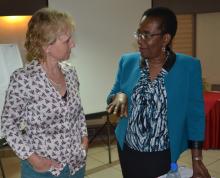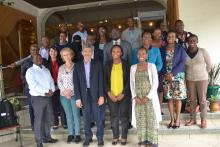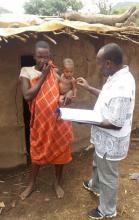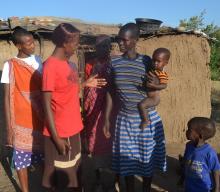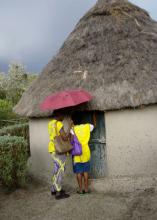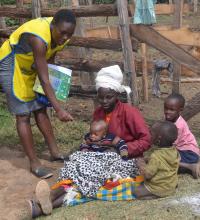Kenya recommended for validation of Maternal and Neonatal Tetanus Elimination
March 9, 2018
Kenya has been recommended for validation of maternal and neonatal tetanus elimination, MNTE. This follows a two-week survey carried out in the country to confirm the absence of neonatal deaths caused by tetanus or “lock-jaw”.
The survey was carried out in Narok County which was selected because of its being the county at highest risk for neonatal tetanus. The risk was considered high due to its poor performance in vaccinating with tetanus-containing vaccine, antenatal visits, delivery by skilled attendants, health staffing, poverty and other human development indices.
The survey which sought to confirm if neonatal tetanus (NT) has been eliminated, followed a pre-validation assessment done in September 2017 by the Ministry of Health with the support from WHO and UNICEF, which was a pre-requisite to the MNTE validation.
The survey reviewed a total of 2,960 live births and 10,366 households in the 337 villages (clusters) visited. Survey results and conclusions showed that less than one neonatal tetanus case in 1000 live births was found. The MNTE validation requirement is for countries to show that they have a reduction of neonatal tetanus incidence to below one case per 1,000 live births in every district or county per year.
These results remove Kenya from the list of 15 countries globally that have yet to achieve MNTE.
The survey found a total of 33 neonatal deaths were reported out of which one neonatal death was due to tetanus. Investigations show the neonatal tetanus death happened last November and is associated with the use of an old blade to cut the umbilical cord. The cause of death for the other 32 deaths was asyphxia (33%), infection (30%), maternal causes (12%), prematurity (9%), congenital anomalies (6%) and birth trauma (3%).
It was also found that the proportion of women of reproductive age receiving at least two doses of tetanus toxoid was 83% while 58% of deliveries were conducted by skilled birth attendants. Fifty seven percent of deliveries were carried out at health facilities. The mothers who received the two doses of tetanus toxoid got them during supplementary immunization activities (immunization campaigns) and during routine immunization.
“If you have more than 80 per cent coverage, you will be validated for elimination of NT and maternal tetanus,” lead international consultant Dr Hilde Sleurs said.
The results and conclusions for the country are based on the assumption that if the county at highest risk of NT can be shown to have eliminated NT, then all counties have eliminated NT in the entire country,” Dr Sleurs, told elated MOH officials and partners.
She cautioned that the results were a “snapshot of the situation, a validation of the true picture at the time of the survey and therefore does not mean activities should stop.”
She said five doses of tetanus toxoid protects a woman for 30 years and after, which means the children a woman she gives birth to throughout the child-bearing period will be protected. One dose of tetanus toxoid is not enough to give protection to the baby or the mother, she added.
The survey further found care givers use traditional substances to clean the cord including breast milk (30 per cent), herbs (20 %), cooking oil (17 %) and other elements including animal faeces, saliva and ash.
It also shows a bigger percentage of mothers received the first vaccination of tetanus toxoid (TT1), at 93 per cent, while those who received TT2 were at 83 % followed by those who received TT3 at 59%. Only a third received TT4 (34 %) while an even smaller number were vaccinated with TT5 at 19 %.
More than a third of the neonatal death cases (36%) were born at home and 33 per cent were not done by skilled birth attendants.
“We are elated to witness this milestone which confirms Kenya is validated from MNTE and the country can be removed from that list of 15 countries”, Dr Joyce Charo, MOH, told partners, and the survey team.
“Congratulations to the many health workers, the county governments, the national MoH and the partners, including our own WHO Kenya team, on this great success,” WHO Kenya Representative Dr Rudi Eggers said.
For the country to sustain the elimination status, MOH and health teams have to closely follow critical steps. These include:
Plan mobile or outreach activities at least 3-4 times per year for hardest to reach places
Promote health facility, assisted and clean delivery
Consider incentives for community health volunteers to mobilize pregnant women to attend four antenatal clinics and two post-natal clinics.
Consider giving incentives to traditional birth attendants to bring women to health facilities for antenatal care and delivery
Strengthen knowledge of health workers on recommended TT immunization schedule
Improve documentation of doses provided through home-based cards, registers, quality of reporting
Promote the “mother-baby package” as an incentive for delivering at health facility
Educate pregnant women on proper cord care during ante-natal care
Increase community awareness on using chlorhexidine or not using anything on the cord
Determine strategies to reach out-of-school population
Ensure availability of chlorhexidine at all levels of health facility providing delivery services
Enhance Surveillance
Prepare county specific recommendations
What is Tetanus?
Tetanus is a non-communicable disease contracted through exposure to the spores of the bacterium, Clostridium tetani, which exists worldwide in soil and in animal intestinal tracts, and as such can contaminate many surfaces and substances.
Tetanus causes muscle stiffness and spasms (lockjaw) and is often fatal; It occurs when wounds are contaminated with tetanus spores (germs); Tetanus infection in a wound produces toxin (poison) that causes the muscle stiffness and spasms;
Tetanus occurring during pregnancy or within 6 weeks of the end of pregnancy is called “maternal tetanus”, while tetanus occurring within the first 28 days of life is called “neonatal tetanus”.
People of all ages can get tetanus but the disease is particularly common and serious in newborn babies and their mothers when the mothers` are unprotected from tetanus by the vaccine, tetanus toxoid.
Tetanus can be prevented through immunization with tetanus-toxoid-containing vaccines (TTCV). Neonatal tetanus can be prevented by immunizing women of reproductive age with TTCV, either during pregnancy or outside of pregnancy. This protects the mother and - through a transfer of tetanus antibodies to the fetus - also her baby. Additionally, clean practices when a mother is delivering a child are also important to prevent neonatal and maternal tetanus.





